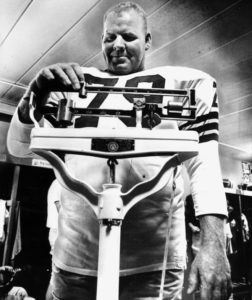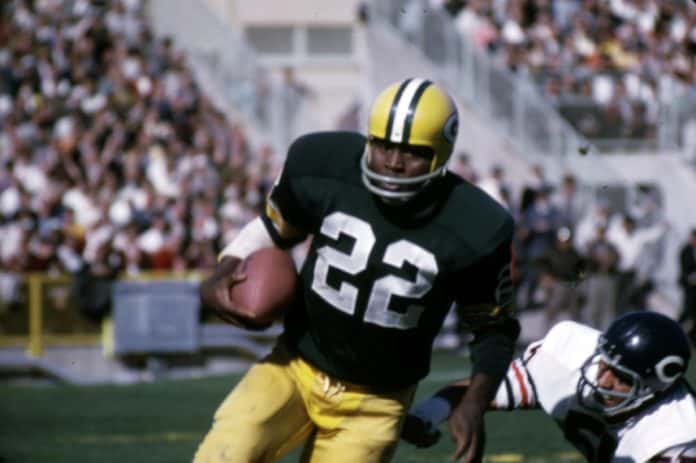The following is from the Arkansas Democrat-Gazette’s “Untold Stories,” a series of feature articles which provide the state’s only detailed resource on its black sports history. Unfortunately this anthology, which preserves a vital part of our state’s heritage, is out of print. It shouldn’t be.
“Untold Stories” deserve to be told again, to return to print and into the hands of thousands of Arkansans who value knowledge about our shared past, black and white alike. You can help make this happen. Click here for more info.
BY JIM BAILEY
No one really knew what to expect from Super Bowl I on Jan. 15, 1967, but most everyone thought they did. NFL fans, scornful of that upstart “cowboy league,” the AFL, were certain the Kansas City Chiefs were in for a fearful drubbing from the Green Bay Packers — maybe on the order of 50-0.
AFL fans, who tended to be anti-establishment types, thought the smug NFL followers were in for the shock of their lives. Both sides were only about half right. The Packers won 35-10. The Chiefs competed well for a half. On the occasion of running back Elijah Pitts’ induction by the Arkansas Sports Hall of Fame 13 years later, Pitts was asked how the Packers approached the historic game.
“Of course we had film on the Chiefs and we respected their personnel,” Elijah Pitts said. “We knew they were a good team but no better than five or six teams we had beaten that year. Put it this way: They wouldn’t have been in the Super Bowl if they’d had to go through the NFL like we did. “There was no way we would take the game lightly. Under Coach Vince Lombardi, you didn’t take anything lightly.”
Pitts, who died at 60 in 1998, was a 13th-round draft choice from Philander Smith College in 1961. He contributed to Lombardi’s four NFL championship teams of the 1960s, including victories in the first two Super Bowls.
As a Buffalo Bills assistant coach approaching Super Bowl XXVI- II, the Bills vs. the Dallas Cowboys at Atlanta, Pitts marveled in an Arkansas Democrat-Gazette interview at the hype quotient 27 years after Green Bay subdued Kansas City. “I talked to more reporters as a running backs coach than I did as the starting halfback for the Packers,” Pitts said. “I never thought the Super Bowl would become what it is.”
A crowd of 61, 946 attended Super Bowl I, leaving 30, 000 empty seats in Los Angeles Memorial Coliseum. “Super Bowl” was still an unofficial nickname: It was formally the NFL-AFL Championship Game and many fans apparently had doubts the AFL could make it a “super” show.
Two weeks earlier, a capacity crowd of 74,152 had watched the Packers outlast the Cowboys 34-27 for the NFL title in the Cotton Bowl at Dallas. Before Super Bowl I, there hadn’t been so much as an exhibition game between the old and new leagues, who made peace in 1966 and started a merger process eventually creating the AFC-NFC structure under the NFL banner.
Pitts scored two touchdowns on short runs against the Chiefs. He would become part of six Super Bowls, going 2-0 as a player with the Packers, 0-4 as a Buffalo assistant.

Go to the 6:00 mark to see the point where Pitts started leaving his mark on Super Bowl I.
Humble origins
Mike Summerville was the first coach to spot athletic potential in Pitts, who grew up in Mayflower and attended Conway Pine Street High in a segregated public school system. Now 75 and retired in Little Rock, Summerville coached at Pine Street in 1953-54, before being hired as athletic director and football coach by his alma mater, Philander Smith.
“I was looking ahead,” Summerville said in a recent interview. “Elijah was in the ninth or 10th grade then, but I could see he’d be a great one. Outside of his ability, he was a wonderful person, a joy to coach. “He had an older brother, Sam, who wasn’t really an outstanding athlete, but I recruited Sam because I felt Elijah would go to college where Sam went, and that’s the way it turned out.”
In 1996, while participating in the Elijah Pitts VIP Celebrity golf tournament, a Philander Smith fund-raiser at Quapaw Golf Links, Pitts reviewed his formative years for a Democrat-Gazette reporter.
“Pine Street was one of the smaller black schools playing football,” he said. “We didn’t play the big schools in Little Rock, North Little Rock, Pine Bluff and Hot Springs. We played like Stamps and Prescott. We did run track against Pine Bluff Merrill, but they would run us right into the ground and laugh at us.”
He said he doubled as the Pine Street tuba player at some games. “I’d take off the shoulder pads, put on a dry T-shirt and march on the field with the band.” Melvin McAlister, a Forrest City lineman who became a Philander Smith teammate of Pitts, already knew about him from high school.
“We [Lincoln] played Pine Street twice and beat them twice, in spite of Pitts,” McAlister said. “He had the great speed but in high school he ran straight up. He’d get to the line straight up and me or somebody would be there to fold him. But when he got loose, nobody would catch him. They called him ‘Pony* or ‘Pony Express’ in high school.
“When he got to Philander, Coach Summerville and [assistant] Leo Moore adjusted his style, got him running lower where he’d more or less explode into the hole.”
Close to home
Pitts had football offers from Illinois, Wisconsin and Michigan State of the Big Ten, plus Arkansas Agricultural, Mechanical & Normal (Arkansas-Pine Bluff), Grambling and Southern of the Southwestern Athletic Conference.
“I had never been away from home and I wanted to stay close,” Pitts said. Since his brother and his former coach were at Philander Smith, “it was the natural place to go.”
By 1959, Pitts’ junior season at Philander Smith, Summerville had left coaching and been hired as Grambling’s dean of men. “Emlen Tunnell was doing a lot of offseason scouting of black schools (for Green Bay 1 and naturally he visited the Grambling campus often, because Eddie Robinson had a powerhouse,” Summerville said. “I told Em about Elijah, and he checked him out at some track meets — liked the way he ran, liked his competitive nature, liked the way he carried himself.
“Even as a kid, he looked like a pro physically. He had everything.”
“I’m sure the [Packers] saw me on a game film they got from AM&N,” Pitts said in 1996. “Philander didn’t do much filming. Sometimes an assistant would be walking around the field with a hand-held camera, and that was about it. My senior year, I had a good game catching the long ball against AM&N. Usually we didn’t throw so much, but we had to open up and try things against teams bigger and deeper than us.”
“Philander never had the resources of the SWAC teams,” Summerville said. “We played in a less ambitious conference with schools like Dillard, Rust, Tugaloo. When we played AM&N, we were sure to be on the short end of a mismatch.”
“I never saw a scout around the Philander campus,” Pitts said. “A scout or two had talked to me at road games, so as a senior I had some hope I might be drafted. The AFL was just getting started [in 1960], so there were jobs for about twice as many guys all of a sudden.”
Turned down AFL
When he enrolled at Philander Smith, he said once, “I always thought NFL players came from the big high schools and the Big Ten colleges, and I didn’t think I had a chance. Growing up in Mayflower, all I thought about was getting a good education, a job around here and raising a family.” The Boston Patriots of the AFL offered him $2,000 more than the Packers, he said.
“My wife — my girlfriend at that time — told me that if I didn’t try the Packers first, shoot for the best, I wasn’t the man she thought I was. If it had been left up to me, I would have tried the easiest league for the most money, but I’ve always been happy it worked out the way it did.”
When Pitts was drafted, Lombardi was preparing for his third season as Green Bay coach. He had already pushed the Packers to the 1960 NFL title game, where they lost to the Philadelphia Eagles 17-13.
Pitts would join a squad including Bart Starr, Jim Taylor, Paul Hornung, Boyd Dowler, Max McGee, Jerry Kramer, Forrest Gregg, Fuzzy Thurston, Willie Wood, Texarkana’s (and Grambling’s) Willie Davis, Herb Adderley, former Arkansas Razorbacks Dave “Hawg” Hanner and Lew Carpenter and even Tunnell at the end of his career. None were legends yet, but most were on the way. Starr, Taylor, Hornung, Gregg, Adderley, Wood, Tunnell and Davis are in the Pro Football Hall of Fame. So, naturally, is Lombardi.

“That was Jerry Kramer’s joke and [sportscaster] Ray Scott gave it wide circulation,” said Pitts, who still found it funny 35 years later. “Actually, I think they all knew who I was after a few days. I went with the attitude that I was as good as anyone.”
***
WANT TO READ THE REST?
I often write about Arkansas’ sports history and heritage. Get notified of my future posts by signing up for the Best Of Arkansas Sports newsletter below. Sign up now, you’ll get the rest of the above Elijah Pitts feature article in your confirmation email.



